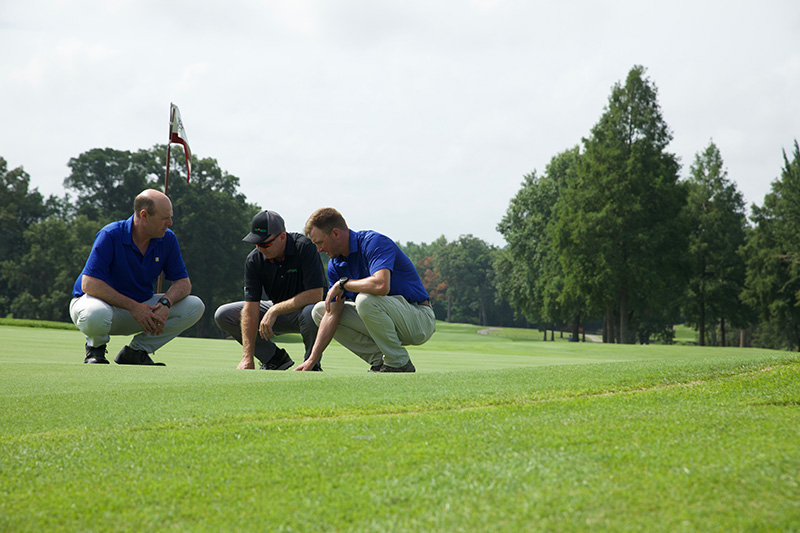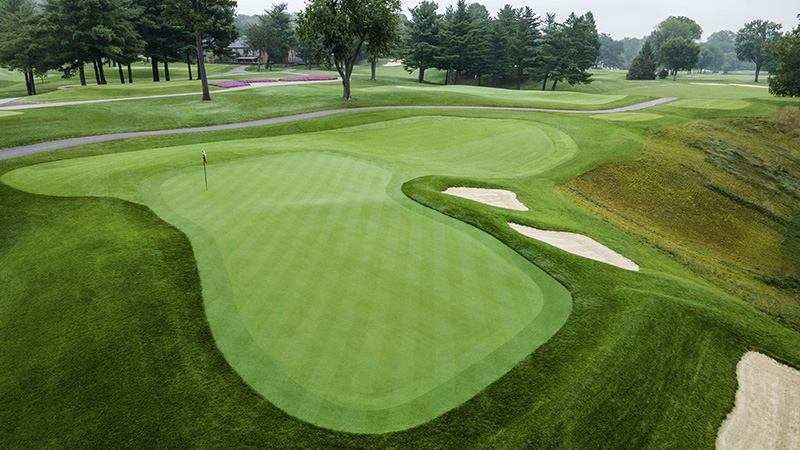
Tee-2-Green agronomist and golf course consultant Lew Sharp talks with the maintenance crew at Evansville (Ind.) Country Club as they review greens conditions. Photos courtesy of Tee-2-Green
Editor's note: The following article was created in partnership with Tee-2-Green. All product claims, research cited and other information is directly from the company.
Renovating or interseeding a course can feel intimidating, but it doesn’t have to be. Over the years, I’ve learned that most successful projects come down to three things: careful planning, smart budgeting, and real-world testing. If you take time to do these things well, your course will play its best for years to come.
Why courses renovate
Golf courses make updates and upgrades all the time, but it’s not always about the turf itself. Believe it or not, peer pressure plays a bigger role than you might expect. Clubs (especially private clubs) often feel forced to upgrade their facilities if nearby courses are doing the same. Golfers notice the changes. They start talking and comparing green speeds, firmness, and how things “felt” to them. There’s a lot of competition that starts bubbling up when it comes to golfers comparing their experiences.
I’m seeing this happen all over the U.S. and Europe. You’ve got new courses in the area, all with brand-new greens. The putting is perfect. Your members go play there, then they come back to your course, where the greens are close to 20 plus years old or older, and suddenly it’s not as “fun” for them anymore. That’s when the pressure to renovate really kicks in.
Another big factor is the recent surge in play during and after the pandemic. Increased rounds meant more traffic, more wear and tear, and heavier demands on greens and tees, many of which were already due for an update.
And honestly, the timing isn’t too bad right now. Many clubs are seeing strong revenues and are reinvesting in longer-term course improvements while they can. For most, it starts with the right conversations: understanding why a renovation is needed before deciding how to approach it.
Timing is everything
In my work at Tee-2-Green, I’d estimate that 75-80% of our projects involve interseeding, with the rest being full renovations. One of the most common questions I get is, “How do I know if my course needs interseeding or a complete renovation?”
Usually, it comes down to what’s happening below the surface. If the structure of the greens, such as drainage, subsoil, or base layers, is compromised — and you’re seeing puddling or black layers — that’s usually a sign that a full renovation is needed.
Interseeding, on the other hand, works when the foundation is solid. Maybe the canopy has thinned from traffic, shade, or environmental stressors like pH imbalance or salt buildup from effluent or reclaimed water. Interseeding lets you introduce seed varieties that perform better under your specific conditions, offering improved traffic, heat, salt or shade tolerance without tearing everything apart.
It’s cost-effective, efficient and adaptable to the course you already have. Even better, you can often get it done without losing additional revenue. In some cases, interseeding is the only choice due to the financial constraints of the golf course.

The eighth green at Evansville Country Club, grown with Pure Distinction seed by Tee-2-Green.
Planning for success
Successful renovations start long before any seed hits the soil. My advice is simple: plan early and plan thoroughly. The best projects I’ve seen are the ones that start years in advance, with superintendents doing their homework and building strong relationships.
Talk to your peers. Learn from others in your region who have gone through similar projects so you understand the real costs of labor, materials, irrigation and everything in between. Consult with agronomists, architects and contractors who know your climate conditions. And above all, stay transparent with your board or golf course ownership. Align your budget with realistic outcomes, set expectations early and communicate often. Laying that groundwork up front will save you a lot of headaches later.
Common mistakes to avoid
Over the years, I’ve seen just about everything that can go wrong on a project. A few patterns turn up time and again:
- Skipping soil and water testing.Test before, during and after construction to monitor pH, salts and nutrients.
- Ignoring sand composition.The wrong greens mix can cause sealing, compaction or poor drainage issues.
- Forgetting to budget for water treatment or amendments.Projects run into trouble not just from high iron, salt or pH levels, but from a lack of the essential nutrients needed to thrive.
- Choosing grass without trialling it locally.What thrives in one region may fail in another. Always test under your site’s conditions so you know how things will shake out in the real world.
One Chicago-area municipal course I worked with through Tee-2-Green offered a good reminder of the importance of field testing. We tested several bentgrass varieties, and one performed exceptionally well with older members who were “foot shufflers.” It surprised us. It was not the variety we expected to hold up best, but that’s exactly why field testing matters.
Best practices and advice
After all the planning, testing and important conversations have taken place, I’ve found a few key habits can separate good projects from great ones:
- Do your homework.Know your course, your players and your limitations.
- Collaborate often. Talk with other local supers, agronomists and golf course boards. Shared experience is your best resource.
- Set realistic expectations.Keep communication open with your team and course leadership. Even well-funded projects can derail when visions are not aligned.
- Test and observe.Always test grass varieties and blends under your actual conditions before making major purchases. Trust me on this one. Shiny and new grasses are sometimes over sold and will fail in three years or less.
- Plan for what you can’t control.Weather, traffic and construction setbacks are bound to happen. It’s like the saying goes, “expect the unexpected.” Budget and schedule with some flexibility in mind.
At the end of the day, renovations and interseeding projects are smart, long-term investments in your course’s quality, sustainability and playability. With the right mix of planning, patience and follow-through, you’ll not only avoid the common pitfalls, but you’ll set your golf course up to truly thrive for years to come.
Lew Sharp is an agronomist and consultant with Tee-2-Green who uses his decades of experience to consult on construction, design, renovation and club management.